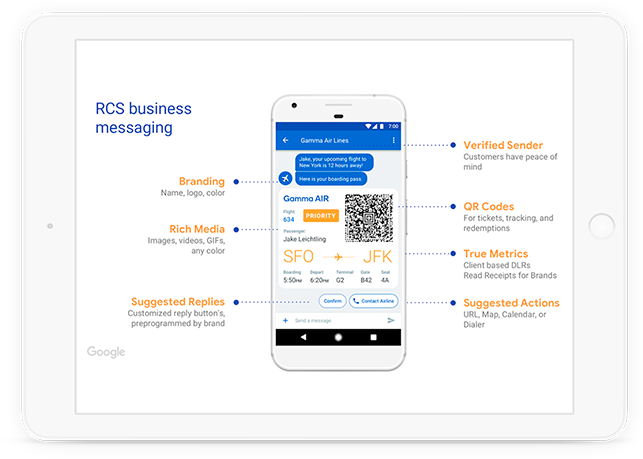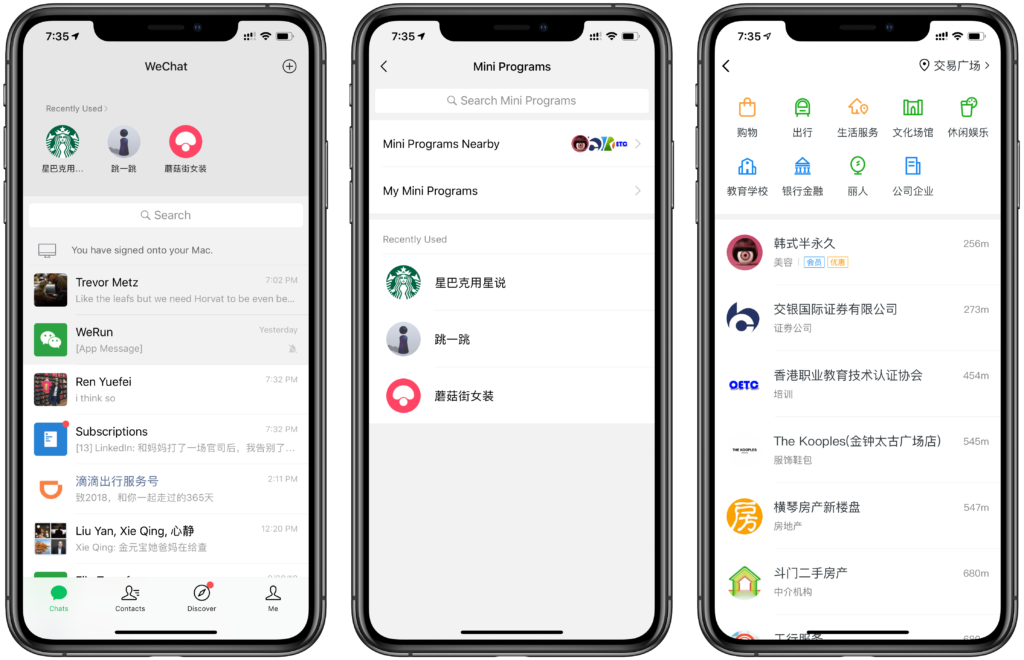I am seeing a pattern lately of RCS launches for major household brands that are no more than a landing page. These shallow RCS experiences are a traffic cop to existing mobile commerce or consumer services and are capitalizing on the eyeballs in this new emerging channel. I understand the argument of “stick your toe in the water” and maybe I should be happy these companies are even willing to test this channel. But, my fear is a less than ideal consumer experience that relegates this only to a marketing channel – SMS/MMS with buttons. This is not what RCS is. Muddying the waters from the initial consumer experience as a pure marketing channel puts a stain on what is possible and trains the consumer’s mind to tread carefully.

The power of RCS at its core is the ability to create applications in the most used communication channel globally. If done correctly, it contains endless power and capabilities. The key value of RCS is bubbling up rich consumer automation inside the channel consumers use most, the native SMS inbox. RCS is the tool to complete tasks for consumers without a download – booking a ticket, e-commerce transactions, customer support, account management, banking and much, much more. All of this can be layered with complex AI efficiencies to make this true channel consumers use to communicate with businesses.
A little background for those new to RCS, Rich Communication Service message is the next evolution of SMS/MMS services on the mobile device. Essentially, RCS brings features of advanced, rich messaging to the native SMS inbox. All the cool buttons, carousels and widgets you see in over-the-top messaging apps like Facebook Messenger, Telegram and WhatsApp will soon be available in the native SMS inbox on your phone. One caveat to date, RCS is only supported natively on Android devices – Apple/iOS has not yet publicly announced support for it. This has been a sticking point for many in the U.S. as iOS has roughly a 45% penetration rate. In markets where Android has a 85% penetration rate or higher, mobile network operators are scrambling to get rich messaging services deployed.
But, companies like nativeMsg have deployed solutions to allow for 100% smartphone support with a fallback RCS style experience. This allows brands to get started with RCS today while reach in the U.S. ecosystem catches-up.
For the most part, RCS must be enabled at the carrier core level and/or on the messaging client application (Google has announced support in the UK and France for RCS on Android Messages). As you can imagine, getting the entire telecommunications industry to adopt and deploy an advanced interoperable standard is a major feat. What has been accomplished to date is pretty impressive considering this will eventually touch every mobile device on the globe in the most utilized communication channel of choice.
Why RCS is positioned to be the next major development platform?
1. No download required.
The application host/run-time environment is or will be installed on every mobile device by default and RCS messages will appear in your native SMS inbox.
Depending on the carrier, device or SMS client you use, you may need to opt-in to some advanced messaging features in the early days. In time, these authorizations will disappear as the expectation will be that you have access to RCS messaging by default. The friction of having to download an app creates a small hurdle that will deter a small portion of people from using an OTT messaging channel to communicate with a business.
Over-the-top apps like Facebook Messenger, Whats App and Telegram have had great success especially in parts of the world where SMS messaging is expensive. In these parts, nothing may change unless RCS messaging/data gets a pricing change. In the U.S. and other markets where SMS is the most used communication channel, this much needed upgrade is being welcomed by consumers. There are more than 5 billion SMS users globally compared to less than 2 billion on the largest individual OTT messaging app. With this, you will have the reach to justify the development efforts similar to the browser.
2. Rich Feature Capabilities
The upgrade from SMS/MMS to RCS messaging service is not a slight one and that makes this even more compelling. You have the most used channel by volume globally upgrading from command line text to a rich text messaging service interface in the year 2019 and beyond. Here are some of the features you will see with RCS: the verified sender giving improved customer peace of mind; branding with name, logo and color; rich media messaging with images, videos, and GIFS; true metrics supplying read receipts and other advanced analytics ; QR codes for tickets, tracking, and redemptions; suggested replies giving customized reply buttons; suggested actions with URL, map, calendar, or dialer functionality (GSMA).
The combination of these rich elements in a texting style format will move SMS to the current state of OTT apps for the most part and allow businesses to communicate with customers on a quick, easy and intuitive platform.
3. Instant Deployment
Compared to a mobile application, RCS deployments can be done instantaneously. Similar to web deployments that don’t require an approval or upgrade on the client side, RCS experiences can be changed and updated on the fly. This makes it much easier and more dynamic than an app. Because of the different mappings at the carrier or non-carrier level, you will want to use a tool, like nativeMsg, who has aggregated all of these connections into one single deployment.
Controlling deployments for RCS will be a key piece of functionality required in a good RCS platform. The ability to turn on/off continuous deployments including a publish feature is a must have once your RCS experience is ready for prime time. Also, versioning and the ability to rollback to previous versions is critical. With instant deployments, this process can tend to be a little more prone to bugs and you will want a way to rollback to a stable version.
4. App Fatigue
There has been this notion of app fatigue for years, but app download numbers keep on increasing. In 2018, global app downloads exceeded 194B, up 35% from 2016, and consumer spend reached $101B in 2018, up 75% From 2016 (The State of Mobile 2019, App Annie). The interesting stat is the average consumer in the U.S. has more than 100 apps on their smartphone, but only 35 of them are being used (The State of Mobile 2019, App Annie). This is in-line with an older Forrester Research report that said consumers spend 85% of time on smartphones in apps, but only 5 apps see heavy use. The net-net is there are more than 75 apps on the average U.S. smartphone that go unused on a monthly basis.
These 75% of apps are ripe for transition into the RCS channel. If I know my phone, these are apps that I used once or twice to achieve a task, like attending a conference, but will never use again. The features that are available in these types of apps can easily be converted into the RCS channel at a much lower cost than building a mobile native app.
The top 6 worldwide apps ranked by monthly active users in 2018 is Facebook, WhatsApp, Facebook Messenger, WeChat, Instagram and QQ (The State of Mobile 2019, App Annie). Apps of this complexity including apps like Uber and financial apps will always have a place on your home screen, but even in these scenarios RCS can used as a gateway via deep linking to the optimal state of the app.
5. RCS is not SMS marketing, it is Application Development
Although many SMS use cases such as marketing promotions and notifications translate, RCS is application development plain and simple. SMS promotional programs that are switching to RCS, like Subway, are seeing great lift in response rates, but there is so much more room for innovation.
Mobile marketing agencies and aggregators are leading the way by trying to slap RCS API on top of existing SMS methodologies and this produces limited experiences. RCS and messaging in general are the next development platform. Think of native application iOS/Android development in the early days. It was much different than web development, but could utilize existing exposed services. It’s the same thing here – completely new paradigm, but the ability to use existing micro-services.
The typical workflows involved in a native or web application will need to be integrated over time to derive great value. Features like authentication, payments, personalization and support moving into the SMS channel is where the magic happens. In time, you will see mobile network operator services integrated like identity, private networks, video calling, billing, etc. This is only the start and the possibilities are endless of what is to come.
But, one thing that concerns me and is the biggest sticking point to complex deployments and a mindset that needs to be changed. RCS cannot live within marketing on the brand side. Product needs to own it and be involved for any true innovation to happen.
6. Trends from the Far East
“The future is already here — it’s just not very evenly distributed.”
William Gibson
We look to WeChat and what is being accomplished in China. WeChat is the largest OTT app in China that has a monthly user base of more than 1 billion people. Inside WeChat, you can play games, pay bills, find local hangouts, book doctor appointments, file police reports, hail taxis, hold video conferences, and access bank services. Now, WeChat has a close relationship with the Chinese government, which has been responsible for banning Facebook, Line and WhatsApp eliminating competition in this market. This has been a major force in the growth and stickiness of the application.
One of the most interesting trends is the concept of mini-programs or apps within the app. The ability to create and deploy applications inside a single host and the success it has had in the WeChat model. This allows businesses to create one application experience usable across all devices, operating systems and networks in theory. WeChat has become the operating system of China to some degree and everyone from start-ups to large brands are providing mini-programs inside of the WeChat mothership.

7. The Ability to See Where you Left Off
From a usability perspective, this is one thing I love about chat applications. My history is right there and all I have to do is scroll up. I can visibly see how I achieved this state. This isn’t limited to RCS per say, but is another advantage of using this type of UI. Tasks that are half completed can be continued without having to authenticate or start-over – this is a major win.
To sum it all up, we know RCS business messaging is coming. It is not a matter of if, but when it will reach main street adoption. Companies need to be ready for the coming change in the SMS inbox as your notification and communication channel will be changing to a full-on host of applications. The way we communicate with our friends and families is how we want to communicate with our most trusted brands and businesses. The rollouts will start to gradually appear and those brands that innovate first will have a leg up on their competitors in this new channel of choice. Reach has been an issue, but with the help of solutions like nativeMsg, 100% smartphone reach for RCS experiences is possible today.
Subscribe to our Newsletter
Free Trial
Get Started With RCS
Business Messaging!
Unlock the power of RCS and revolutionize your customer engagement.


